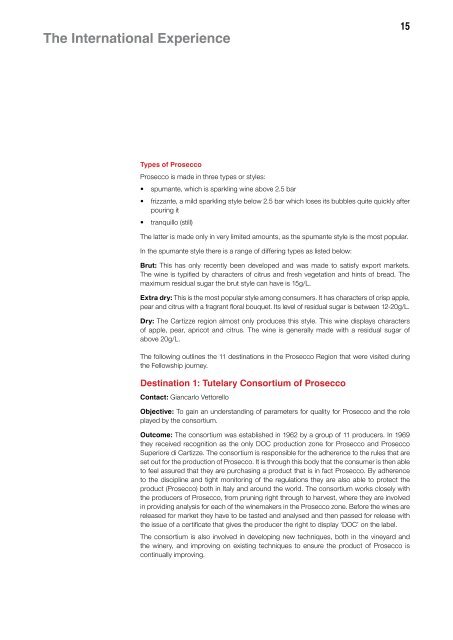Prosecco: a Grape Variety From the Veneto Region - International ...
Prosecco: a Grape Variety From the Veneto Region - International ...
Prosecco: a Grape Variety From the Veneto Region - International ...
Create successful ePaper yourself
Turn your PDF publications into a flip-book with our unique Google optimized e-Paper software.
The <strong>International</strong> Experience<br />
Types of <strong>Prosecco</strong><br />
<strong>Prosecco</strong> is made in three types or styles:<br />
• spumante, which is sparkling wine above 2.5 bar<br />
• frizzante, a mild sparkling style below 2.5 bar which loses its bubbles quite quickly after<br />
pouring it<br />
• tranquillo (still)<br />
The latter is made only in very limited amounts, as <strong>the</strong> spumante style is <strong>the</strong> most popular.<br />
In <strong>the</strong> spumante style <strong>the</strong>re is a range of differing types as listed below:<br />
Brut: This has only recently been developed and was made to satisfy export markets.<br />
The wine is typified by characters of citrus and fresh vegetation and hints of bread. The<br />
maximum residual sugar <strong>the</strong> brut style can have is 15g/L.<br />
Extra dry: This is <strong>the</strong> most popular style among consumers. It has characters of crisp apple,<br />
pear and citrus with a fragrant floral bouquet. Its level of residual sugar is between 12-20g/L.<br />
Dry: The Cartizze region almost only produces this style. This wine displays characters<br />
of apple, pear, apricot and citrus. The wine is generally made with a residual sugar of<br />
above 20g/L.<br />
The following outlines <strong>the</strong> 11 destinations in <strong>the</strong> <strong>Prosecco</strong> <strong>Region</strong> that were visited during<br />
<strong>the</strong> Fellowship journey.<br />
Destination 1: Tutelary Consortium of <strong>Prosecco</strong><br />
Contact: Giancarlo Vettorello<br />
Objective: To gain an understanding of parameters for quality for <strong>Prosecco</strong> and <strong>the</strong> role<br />
played by <strong>the</strong> consortium.<br />
Outcome: The consortium was established in 1962 by a group of 11 producers. In 1969<br />
<strong>the</strong>y received recognition as <strong>the</strong> only DOC production zone for <strong>Prosecco</strong> and <strong>Prosecco</strong><br />
Superiore di Cartizze. The consortium is responsible for <strong>the</strong> adherence to <strong>the</strong> rules that are<br />
set out for <strong>the</strong> production of <strong>Prosecco</strong>. It is through this body that <strong>the</strong> consumer is <strong>the</strong>n able<br />
to feel assured that <strong>the</strong>y are purchasing a product that is in fact <strong>Prosecco</strong>. By adherence<br />
to <strong>the</strong> discipline and tight monitoring of <strong>the</strong> regulations <strong>the</strong>y are also able to protect <strong>the</strong><br />
product (<strong>Prosecco</strong>) both in Italy and around <strong>the</strong> world. The consortium works closely with<br />
<strong>the</strong> producers of <strong>Prosecco</strong>, from pruning right through to harvest, where <strong>the</strong>y are involved<br />
in providing analysis for each of <strong>the</strong> winemakers in <strong>the</strong> <strong>Prosecco</strong> zone. Before <strong>the</strong> wines are<br />
released for market <strong>the</strong>y have to be tasted and analysed and <strong>the</strong>n passed for release with<br />
<strong>the</strong> issue of a certificate that gives <strong>the</strong> producer <strong>the</strong> right to display ‘DOC’ on <strong>the</strong> label.<br />
The consortium is also involved in developing new techniques, both in <strong>the</strong> vineyard and<br />
<strong>the</strong> winery, and improving on existing techniques to ensure <strong>the</strong> product of <strong>Prosecco</strong> is<br />
continually improving.<br />
15

















